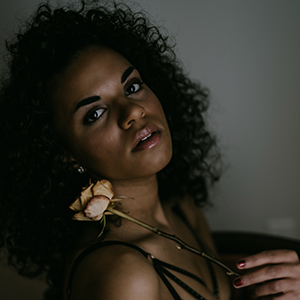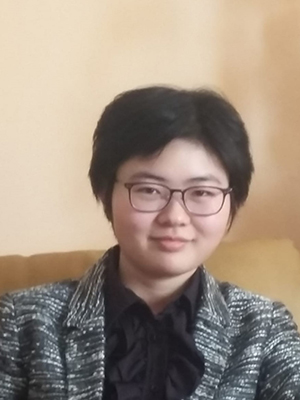Emotion & Poetry: Kathy Mak in Conversation with Leslie Joy Ahenda

Leslie Joy Ahenda, whose poems “Venus,” “even the knifefish learns to flee,” and “to outlast an active volcano” appear in The Malahat Review’s spring issue #214, discusses mythos, momentum, and meaning in her Q&A with Malahat Review volunteer and past contributor Kathy Mak. Read "Venus" here.
Leslie Joy Ahenda is an MFA candidate at the University of Guelph and the poetry editor for Augur Magazine. She is a finalist for the Alberta Magainze Publishers' Award for Poetry. Her work has appeared in CV2, Plenitude Magazine, filling Station, and more. Her debut chapbook, THRENODY FOR A DROWNED GIRL (2021), is available from Moon Jelly House.
[Photo credit: Bailey Morgan Photography]
Of the trio of poems, “Venus” begins with a reference to Erik Olson’s oil painting. The Roman goddess and the epithets she embodies are further explored through a metaphorical lens of planetary formation and cessation. As a deity who represents love, victory, and sexuality, what drew you to writing about Venus and the roles she holds?
I was drawn first and foremost to the planet. Calling upon the goddess became necessary only because it is impossible to divorce the name “Venus” from its mythos. When I went off researching the planet to give it personhood and explore the feelings that I had, I knew it would be disingenuous to ignore the mythology of the goddess. But what really fascinates me is the body of the planet itself. The way it moves and functions, and what its behaviour evokes. I consider this poem to be quite literal, although I understand that very few people will read it that way.
The sensuality in the poem comes directly out of the Erik Olson painting. Really, all the emotion in the poem is simply what the painting pulled out of me. If I had been looking at an image from NASA or even somebody else’s artistic rendition of the planet, this would have been a completely different poem.
I often begin in the scientific when I write poetry. I think that I was meant to be a scientist, but unfortunately, I can’t do math. So instead of pursuing study in a scientific field, I write science poems. This way, I can say, “look at this incredible feat of nature! Isn’t it spectacular?” If people are intrigued by the subject matter, then I feel I’ve succeeded as a scientist. And if people read these poems and pick up on a metaphor that speaks to them, if the poems make them feel any type of way, then I feel I’ve succeeded as a poet.
I love the sense of momentum in “even the knifefish learns to flee.” Beginning with a smooth, fluid depiction of the environment, “& i plunge & i count how many currents / the water conducts in nightquiet secret,” it transpires to a greater urgency towards the core of the poem: “& unlike the eel it cannot shock / & unlike the siren it cannot sing / & unlike me it can detect harm before harm.” Even in a habitat the knifefish is accustomed to, there is still a predatory omniscience that haunts the waters. Escape becomes dire. From my interpretation, there seems to be an underlying connection to sexual violence. How did this poem come to be and why did you decide to write about the knifefish in particular?
This is another instance where the science came first, and it’s another poem that I take quite literally. I stumbled upon the Wikipedia page for the order Gymnotiformes, commonly named “knifefish” because of their body shape. I read that the majority of gymnotiforms (of which there are approximately 250 species) have organs that produce electricity—not enough to cause harm to any creature, but enough to detect obstacles in their paths and to communicate with each other. I read that and said, “That’s a poem.” I don’t have to make up a metaphor because it already feels true to life just as it is.
I’ll leave your interpretation to you, and others’ interpretations to them. I won’t comment on what one ought to interpret, nor will I explain what I meant because I don’t think that matters. What matters is that we can read this information about a fish and come away with a framework for understanding some aspect of our lives. As a poet, I’m not here to tell you what to think of the knifefish; I’m just here to tell you it exists and to show you what I felt when I learned about it.
“to outlast an active volcano” is graced with sparse punctuation. The fluctuation in tone and use of rhetorics builds and cuts through the emotions in a fiery ball of honesty. How do you go about punctuating your poems? And how do you balance the technicalities of writing with the organic flow of art?
The short answer is that I don’t spend very much time thinking about punctuation or the technicalities of writing. I just do what feels right. I’m sure that’s a deeply unsatisfying answer, but it’s the truth.
“volcano” is an odd poem for me because it actually means something—on purpose. Most of my poems only mean something by accident. This one was a fluke because it didn’t feel entirely literal when I was writing it. Even still, I’m dealing with the science of volcanoes. I think it can be read as though it is truly about a volcano, and that would be a satisfying reading.
In my mind, the volcano is very explicitly one person, so everything in the poem flowed from my experiences with this person. It’s full of question marks because I have a lot of unanswerable questions. It ends with a period because the emotion in the ending feels terribly certain. That’s it. I wasn’t concerned with grammar or syntax. All that mattered to me was that the experience of reading the poem would match the feeling that each line evoked in me.
On your website, you mention you were previously an editorial intern at The Malahat Review. You have also edited at This Side of West and you’re currently the poetry editor of Augur Magazine. Have these experiences influenced the way you approach your own writing or shifted your perspective on the CanLit community?
I’ve been editing for as long as I’ve been writing. The project of editing, to me, is entirely about community and how I can be of service. The biggest lesson that editing has taught me is that it’s not about me. There is no room for ego as an editor. Forcing the ego to sit in the back and be quiet has made me a more conscientious editor; I believe it has also made me a better writer and, hopefully, a better person.
The point of being a poet, for me, is not to centre the self. It’s not to say, “look how clever I am,” or, “look at all that I have suffered.” I wrote poems like that for a few years, and I don’t discredit people for whom that is the point of writing. But for me, getting rid of the ego has allowed me to go to much more interesting and honest places in my work. Now, the point of writing a poem is to create an offering. Once the poem is written, it’s not for me anymore. It’s for the person reading it. My project as a poet is to be of service to my community, not to myself.
Writing isn’t easy. It is a journey of continual dedication and perseverance, and many creators have experienced changes to their practise since the pandemic began. Why do you write and what keeps you going?
I write because I don’t know how else to say what I feel. I have always found it impossible to describe my emotions accurately. So instead, I write about a fish, or a planet, or a volcano. I keep writing because I keep having feelings. For as long as I have emotions, I think I’ll have to keep going.
I can’t say that I have a writing practice, really. Some people write a poem every day or every week. Some people get up at 5 in the morning and bang out their two pages before they start their day. I admire and respect these people deeply. I am woefully incapable of that sort of consistency and structure.
To me, there is no difference between emotion and poetry: they’re both chaotic, unpredictable, fleeting. Life is that way, too. So, I write because I feel, and I feel because I am alive.

Kathy Mak
* * * * * * * *









